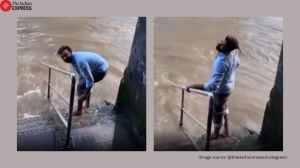Stay updated with the latest - Click here to follow us on Instagram
Row, Row, Row Your Boat
You could be professor or punter, but you can't ignore the river in this university town.
Amrita Roy
The view of Cambridge as framed by the windows of the Pembroke College Boating Club on a mid- April afternoon is out of a tourist brochure. Swans glide by, stark white against the brilliant blue of the Cam river. Houseboats painted red and green are moored along the opposite bank. Strains of a trumpet float up from downstream. A young couple is feeding bread to the ducks. An old couple on a bench watch them drowsily. A woman lies in the grass lost in her book.
At the boathouse, one of many dotting the river – most are emblazoned with the coats of arms of various colleges and the Cambridge University – Tom Hoier, a third-year student of chemical engineering, keeps a sharp eye on his mate Will Yasher slicing through the river in a white canoe. This is Yasher’s first year as a rower and he is “novicing”. He picked up the sport after coming to Cambridge as an exchange student from the Massachusetts Institute of Technology, US. “It’s such a Cambridge thing to do,” he says.
It’s just days after the 160th edition of the fiercely competitive annual Boat Race between Oxford and Cambridge held on the Thames in London. Despite starting well, Cambridge lost woefully (by 11 lengths) after a clash of oars caused one of their rowers to briefly fall from his seat. The star-studded Oxford team, including three Olympians, never let their arch rivals recover. There’s some consolation, though: Oxford still trails 78-81 in the overall tally of the races that started in 1829.
A few hundred metres down the river from the Pembroke boat club, Dan Richards has no time for such heartburn. A trainer with the Scudamore Punting Company, the 24-year-old is busy preparing a training module for new chauffers before the tourist season starts on Easter. Punts are flat-bottomed boats with square prows originally used to carry cargo up the shallow river; chauffers propel them by driving long poles into the riverbed. The colleges along the river still maintain their own punts and have private mooring areas.
As commercial traffic declined and the river cleaned up after a modern sewage network was built in the 1880s, the trend of punting for pleasure took off around the turn of the 20th century. Punting companies were set up and chauffers doubled up as tourist guides. Richards, who grew up in Cambridge and started punting as a teenager, has tried his hands at various other professions, even interning at a stock broker in London. But having grown up on the river, he soon realized that city life was not for him. “I wanted to be outdoors,” he says. And so he returned as a trainer to Scudamores, where he had begun his career as a chauffer.
Punting and rowing are traditions anchored in the “watery” past that has shaped the town’s history, even giving it its name. Lying at the tip of the Fens, a roughly inverted triangle-shaped, floodprone, marshy tract stretching to the North Sea, Cambridge owes much of its historic grandeur to its geography. There had been human habitation in and around Cambridge since pre-historic times – Fitzwilliam College (one of the newer colleges founded in 1869) stands atop the remains of a 3,500- year-old farm – but the Romans first realised its strategic and commercial potential. The Cam, a tributary of Great Ouse, opens up a direct channel from the North Sea into the heart of England, with London just 80km away. “A defendable fort beside a crossing point of a river navigable to the North Sea was particularly attractive to the Romans (and to subsequent invaders of eastern England),” writes local historian Nicholas Chrimes in Cambridge: Treasure Island in the Fens. It was the Saxons who gave Cambridge its name, though in those days it was called “Grantabrycge” or the bridge over river Granta, as the Cam was then known in its upper course.
The prosperity of Cambridge and the tranquility of the fens drew another group of settlers. Since the Romans, monks of various orders found retreat in the isolation of the fens. After the Norman conquest of 1066 they started acquiring land and established monasteries. Into this milieu, in 1209, stepped a group of scholars from Oxford, fleeing persecution at the hands of the townsfolk. And thereby set the foundation of a new university and changed the course of the town’s history for ever. It would take several centuries and unprecedented royal patronage before the fledgling university would outshine older rivals like Stamford and Northampton, and seal its repute alongside Oxford. However, as the university grew in power and prestige – it was awarded the authority to monitor weights and measures and levy various duties and in 1827 the vice-chancellor was named one of the river commissioners alongside the mayor – a rift grew between the town and the scholars.
The one Cambridge tradition that bridges that divide is punting. Floating down the river on a balmy summer evening with a cooling can of beer in hand is something collegiates and non-collegiates participate in equally enthusiastically. The popularity of punting is thanks to a Boer War veteran, Jack Scudamore. A boat builder’s apprentice, he returned home from war in the early 1900s, set up his own business and started hiring out punts for trips. The remnants of an underwater raised walkway, built for horses towing cargo punts through the middle of the river, makes the Cam particularly punt-friendly.
Another group of soldiers, the American and European servicemen stationed around Cambridge during the Second World War, would do their bit to popularise punting. Richards recounts a popular anecdote: during the War, punts had to be paddled due to a shortage of poles. A sign saying, “Sorry, no poles”, put up by Scudamores had to be taken down when the Polish soldiers flooded its office with complaints.
It remains a popular pastime as millions of tourists sail in their wake each year. It helps that the best views of the iconic Cambridge architecture are to be had from the river as it meanders down from the historic Quayside opposite Magdalene College, under the Bridge of Sighs at St John’s College and past the King’s College chapel through the picturesque Backs down to the ancient Silver Street. For 40-year-old sessions musician Neil Waters, the summer months are of much less concern. Living on a floating home on the river, it’s the winter that he is wary of. Despite the wood-burning stove, the windows had frozen over a few years ago. But the winter just past was mild and on this balmy spring day, as he practices on his trumpet with his two dogs for company inside his cosy “drawing room” on a Dutch barge, moored on a particularly picturesque stretch of the river along the Midsummer Common, he looks at peace with the world. Waters had not considered living on a houseboat till he and his partner started looking for a house to buy. Stumped by the prohibitive prices in Cambridge, they had been faced with the prospect of continuing to rent for ever when a friend who lived on a houseboat suggested they buy one too. The hull of their home, named Djovaki, came from a commercial barge built in 1902; the cabins were built in 1972 by the previous owner. With a bedroom, a fully fitted kitchen and a drawing room, it cost £40,000 – or approximately the deposit he would have had to put down to get a mortgage for a three-bed property on the outskirts of Cambridge Now he lives in the heart of the town.
Six and half years later, Waters says he doesn’t miss living in a house. Life on the water is more relaxed, and that suits his artist’s temperament. He could do with a garden though, he says. And then as his eyes sweep over the treelined expanse of the Midsummer Common dotting with early spring blooms, he adds as an afterthought, “But then what garden could match this.”
Amrita Roy is a freelance writer based in Cambridge, London







